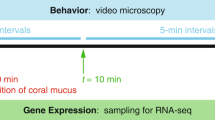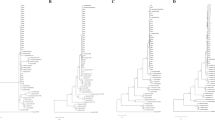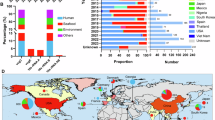Abstract
Vibrio coralliilyticus has been implicated as an important pathogen of coral species worldwide. In this study, the nearly complete genome of Vibrio coralliilyticus strain P1 (LMG23696) was sequenced and proteases implicated in virulence of the strain were specifically investigated. The genome sequence of P1 (5 513 256 bp in size) consisted of 5222 coding sequences and 58 RNA genes (53 tRNAs and at least 5 rRNAs). Seventeen metalloprotease and effector (vgrG, hlyA and hcp) genes were identified in the genome and expressed proteases were also detected in the secretome of P1. As the VcpA zinc-metalloprotease has been considered an important virulence factor of V. coralliilyticus, a vcpA deletion mutant was constructed to evaluate the effect of this gene in animal pathogenesis. Both wild-type and mutant (ΔvcpA) strains exhibited similar virulence characteristics that resulted in high mortality in Artemia and Drosophila pathogenicity bioassays and strong photosystem II inactivation of the coral dinoflagellate endosymbiont (Symbiodinium). In contrast, the ΔvcpA mutant demonstrated higher hemolytic activity and secreted 18 proteins not secreted by the wild type. These proteins included four types of metalloproteases, a chitinase, a hemolysin-related protein RbmC, the Hcp protein and 12 hypothetical proteins. Overall, the results of this study indicate that V. coralliilyticus strain P1 has a diverse virulence repertoire that possibly enables this bacterium to be an efficient animal pathogen.
Similar content being viewed by others
Log in or create a free account to read this content
Gain free access to this article, as well as selected content from this journal and more on nature.com
or
Accession codes
References
Alves Jr N, Maia Neto OS, Silva BO, Moura RL, Francini-Filho RB, Barreira e Castro C et al. (2010). Diversity and pathogenic potential of vibrios isolated from Abrolhos Bank coral. Environ Microbiol Reports 2: 90–95.
Austin B, Austin D, Sutherland R, Thompson F, Swings J . (2005). Pathogenicity of vibrios to rainbow trout (Oncorhynchus mykiss, Walbaum) and Artemia nauplii. Environ Microbiol 7: 1488–1495.
Aziz RK, Bartels D, Best AA, DeJongh M, Disz T, Edwards RA et al. (2008). The RAST Server: rapid annotations using subsystems technology. BMC Genomics 8: 9–75.
Ben-Haim Y, Thompson FL, Thompson CC, Cnockaert MC, Hoste B, Swing J et al. (2003a). Vibrio coralliilyticus sp. nov., a temperature-dependent pathogen of the coral Pocillopora damicornis. Int J Syst Evol Microbiol 53: 309–315.
Ben-Haim Y, Zicherman-Keren M, Rosenberg E . (2003b). Temperature-regulated bleaching and lysis of the coral Pocillopora damicornis by the novel pathogen Vibrio coralliilyticus. Appl Environ Microbiol 69: 4236–4242.
Binesse J, Delsert C, Saulnier D, Champomier-Verge's M, Zagorec M, Munier-Lehmann H et al. (2008). Metalloprotease vsm is the major determinant of toxicity for extracellular products of Vibrio splendidus. Appl Environ Microbiol 74: 7108–7117.
Blow NS, Salomon RN, Garrity K, Reveillaud I, Kopin A, Jackson FR et al. (2005). Vibrio cholerae infection of Drosophila melanogaster mimics the human disease cholera. PLoS Pathogens 1: 1–14.
Bourne DG, Garren M, Work TM, Rosenberg E, Smith GW, Harvell CD . (2009). Trends Microbiol 17: 554–562.
Bourne DG, Munn CB . (2005). Diversity of bacteria associated with the coral Pocillopora damicornis from the Great Barrier Reef. Environ Microbiol 7: 1162–1174.
Boyd JM, Dacanay A, Knickle LC, Touhami A, Brown LL, Jericho MH et al. (2008). Contribution of type IV pili to the virulence of Aeromonas salmonicida subsp. salmonicida in atlantic salmon (Salmo salar L.). Infec Imun 76: 1445–1455.
Chimetto LA, Brocchi M, Thompson CC, Martins RC, Ramos HR, Thompson FL . (2008). Vibrios dominate as culturable nitrogen-fixing bacteria of the Brazilian coral Mussismilia hispida. Syst Appl Microbiol 31: 312–319.
Coelho A, de Oliveira Santos E, Faria ML, de Carvalho DP, Soares MR, von Kruger WM et al. (2004). A proteome reference map for Vibrio cholerae El Tor. Proteomics 4: 1491–1504.
Denkin SM, Nelson DR . (1999). Induction of protease activity in Vibrio anguillarum by gastrointestinal mucus. Appl Environ Microbiol 65: 3555–3560.
Dinsdale EA, Pantos O, Smriga S, Edwards RA, Angly F, Wegley L et al. (2008). Microbial ecology of four coral atolls in the Northern Line Islands. PLoS One 3: e1584.
Hallin PF, Binnewies TT, Ussery DW . (2008). The genome BLAST atlas-a Genewiz extension for visualization of whole genome homology. MolBiosyst 4: 363–371.
Hasegawa H, Häse CC . (2009). The extracellular metalloprotease of Vibrio tubiashii directly inhibits its extracellular haemolysin. Microbiology 155: 2296–2305.
Hasegawa H, Lind EJ, Boin MA, Häse CC . (2008). The extracellular metalloprotease of Vibrio tubiashii is a major virulence factor for pacific oyster (Crassostrea gigas) larvae. Appl Environ Microbiol 74: 4101–4110.
Hellman U, Wernstedt C, Gonez J, Heldin CH . (1995). Improvement of an ‘In-Gel’ digestion procedure for the micropreparation of internal protein fragments for amino acid sequencing. Anal Biochem 224: 451–455.
Hermes HF, Sonke T, Peters PJ, van Balken JA, Kamphuis J, Dijkhuizen L et al. (1993). Purification and characterization of an L-aminopeptidase from Pseudomonas putida ATCC 12633. Appl Environ Microbiol 59: 4330–4334.
Heussen C, Dowdle EB . (1980). Electrophoretic analysis of plasminogen activators in polyacrylamide gels containing sodium dodecyl sulphate and copolymerized substrates. Anal Biochem 102: 196–202.
Hughes TP, Baird AH, Bellwood DR, Card M, Connolly SR, Folke C et al. (2003). Climate change, human impacts, and the resilience of coral reefs. Science 301: 929–933.
Ishikura M, Hagiwara K, Takishita K, Haga M, Iwai K, Maruyama T . (2004). Isolation of new Symbiodinium strains from Tridacnid giant clam (Tridacna crocea) and sea slug (Pteraeolidia ianthina) using culture medium containing giant clam tissue homogenate. Mar Biotechnol 6: 378–385.
Kamphuis E, Meijer M, Boesten WH, Sonke T, van den Tweel WJ, Schoemaker HE . (1992). New developments in the synthesis of natural and unnatural amino acids. Ann N Y Acad Sci 672: 510–527.
Kato T, Takahashi N, Kuramitsu HK . (1992). Sequence analysis and characterization of the Porphyromonas gingivalis prtC gene, which expresses a novel collagenase activity. J Bacteriol 174: 3889–3895.
Kiessling W, Simpson C, Foote M . (2010). Reefs as cradles of evolution and sources of biodiversity in the Phanerozoic. Science 327: 196–198.
Knowlton N, Jackson JB . (2008). Shifting baselines, local impacts, and global change on coral reefs. PLoS Biol 6: e54.
Le Roux F, Binesse J, Saulnier D, Mazel D . (2007). Construction of a Vibrio splendidus mutant lacking the metalloprotease gene vsm by use of a novel counterselectable suicide vector. Appl Environ Microbiol 73: 777–784.
Lery LM, Coelho A, von Kruger WM, Gonçalves MS, Santos MF, Valente RH et al. (2008). A comparative proteomic analysis of Gluconacetobacter diazotrophicus PAL5 at exponential and stationary phases of cultures in the presence of high and low levels of inorganic nitrogen compound. Biochim Biophys Acta 1784: 1578–1589.
Liu PC, Lee KK, Chen SN . (1996). Pathogenicity of different isolates of Vibrio harveyi in tiger prawn, Penaeus monodon. Lett Appl Microbiol 22: 413–416.
Loghothetis PN, Austin B . (1996). Variations in antigenicity of Aeromonas hydrophila strains in rainbow trout (Oncorhynchus mykiss, Walbaum): an association with surface characteristics. Fish Shellfish Immunol 6: 47–55.
Luna GM, Biavasco F, Danovaro R . (2007). Bacteria associated with the rapid tissue necrosis of stony corals. Environ Microbiol 9: 1851–1857.
Margulies M, Egholm M, Altman WE et al. (2005). Genome sequencing in microfabricated high-density picolitre reactors. Nature 437: 376–380.
Matsui M, Fowler JH, Walling LL . (2006). Leucine aminopeptidases: diversity in structure and function. Biol Chem 387: 1535–1544.
Milton DL, Norqvist A, Wolf-Watz H . (1992). Cloning of a metalloprotease gene involved in the virulence mechanism of Vibrio anguillarum. J Bacteriol 174: 7235–7244.
Miyoshi S-I, Wakae H, Tomochika K-I, Shinoda S . (1997). Functional domains of a zinc metalloprotease from Vibrio vulnificus. J Bacteriol 179: 7606–7609.
Mo Z, Guo D, Mao Y, Ye X, Zou Y, Xiao P et al. (2010). Identification and characterization of the Vibrio anguillarum prtV gene encoding a new metalloprotease. Chinese J Oceanol Limnol 28: 1–14.
Park J, Ryu S-Y, Kim C–M, Shin S-H . (2008). Two forms of Vibrio vulnificus metalloprotease VvpE are secreted via the type II general secretion system. J Microbiol 46: 338–343.
Pedersen AG, Jensen LJ, Brunak S, Staerfeldt HH, Ussery DW . (2000). A DNA structural atlas for Escherichia coli. J Mol Biol 299: 907–930.
Pitcher DG, Saunders NA, Owen RJ . (1989). Rapid extraction of bacterial genomic DNA with guanidium thiocyanate. Lett Appl Microbiol 8: 151–156.
Rawlings ND, Tolle DP, Barrett AJ . (2004). Evolutionary families of peptidase inhibitors. Biochem J 378: 705–716.
Rohwer F, Youle M . (2010). Coral Reefs in the Microbial Seas. Plaid Press: Basalt, CO, 204 p.
Sussman M, Mieog JC, Doyle J, Victor S, Willis BL, Bourne DG . (2009). Vibrio zinc-metalloprotease causes photoinactivation of coral endosymbionts and coral tissue lesions. PLoS ONE 4: 1–14.
Sussman M, Willis BL, Victor S, Bourne DG . (2008). Coral pathogens identified for white syndrome epizootics in the Indo-Pacific. PLoS ONE 3: 1–14.
Sutherland KP, Porter JW, Torres DG . (2004). Disease and immunity in Caribbean and Indo-Pacific zooxanthellate corals. Mar Ecol Prog Ser 266: 273–302.
Vaitkevicius K, Lindmark B, Ou G, Song T, Toma C, Iwanaga M et al. (2006). A Vibrio cholerae protease needed for killing of Caenorhabditis elegans has a role in protection from natural predator grazing. Proc Natl Acad Sci USA 103: 9280–9285.
Vaitkevicius K, Rompikuntal PK, Lindmark B, Vaitkevicius R, Song T, Wai SN . (2008). The metalloprotease PrtV from Vibrio cholerae. FEBS J 275: 3167–3177.
Van Oppen MJH, Palstra FP, Piquet AMT, Miller DJ . (2001). Patterns of coral-dinoflagellate associations in Acropora: significance of local availability and physiology of Symbiodinium strains and host-symbiont selectivity. Proc R Soc Lond [Biol] 268: 1759–1767.
Varina M, Denkin SM, Staroscik AM, Nelson DR . (2008). Identification and characterization of Epp, the secreted processing protease for the Vibrio anguillarum EmpA metalloprotease. J Bacteriol 190: 6589–6597.
Vega Thurber R, Willner-Hall D, Rodriguez-Mueller B, Desnues C, Edwards RA, Angly F et al. (2008). Metagenomic analysis of stressed coral holobionts. Environ Microbiol 11: 2148–2163.
Wang J, Sasaki T, Maehara Y, Nakao H, Tsuchiya T, Miyoshi S . (2008). Variation of extracellular proteases produced by Vibrio vulnificus clinical isolates: Genetic diversity of the metalloprotease gene (vvp), and serine protease secretion by vvp-negative strains. Microb Pathogenesis 44: 494–500.
Wilkinson C . (2008). Status of Coral Reefs of the World 2008. Australian Institute of Marine Science: Townsville, Australia.
Yip ES, Grublesky BT, Hussa EA, Visick KL . (2005). A novel, conserved cluster of genes promotes symbiotic colonization and sigma-dependent biofilm formation by Vibrio fischeri. Mol Microbiol 57: 1485–1498.
Acknowledgements
We would like to thank the Luz Síncroton National Laboratory for the use of the nano-LC-MS/MS mass spectrometer and Proteomic Network of Rio de Janeiro for equipment and reagent lending. We thank Gabrielle V Souza for her excellent technical assistance. This study was partially funded by grants from the National Council of Technological and Scientific Development, Brazil (CNPq). BW thanks a Smart state postdoctoral fellowship. FLT and EOS have CNPq fellowships.
Author information
Authors and Affiliations
Corresponding author
Additional information
Supplementary Information accompanies the paper on The ISME Journal website
Supplementary information
Rights and permissions
About this article
Cite this article
de O Santos, E., Alves, N., Dias, G. et al. Genomic and proteomic analyses of the coral pathogen Vibrio coralliilyticus reveal a diverse virulence repertoire. ISME J 5, 1471–1483 (2011). https://doi.org/10.1038/ismej.2011.19
Received:
Revised:
Accepted:
Published:
Issue date:
DOI: https://doi.org/10.1038/ismej.2011.19
Keywords
This article is cited by
-
Global Distribution of Hard Coral Pathogen Vibrio coralliilyticus; an Ensemble Modelling Approach
Thalassas: An International Journal of Marine Sciences (2023)
-
Experimental transmission of Stony Coral Tissue Loss Disease results in differential microbial responses within coral mucus and tissue
ISME Communications (2022)
-
Microscale tracking of coral-vibrio interactions
ISME Communications (2021)
-
Delineating virulence of Vibrio campbellii: a predominant luminescent bacterial pathogen in Indian shrimp hatcheries
Scientific Reports (2021)
-
Integrating novel tools to elucidate the metabolic basis of microbial symbiosis in reef holobionts
Marine Biology (2021)



